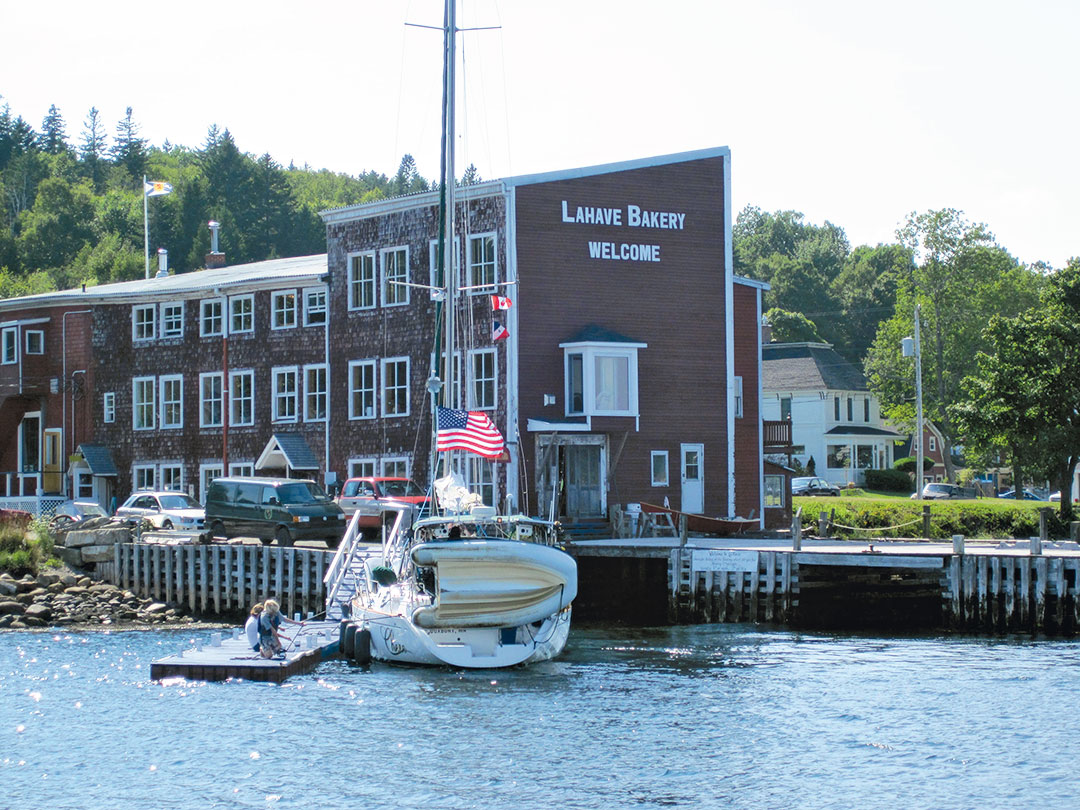Anxiety can scuttle everyone’s time aboard. Here’s how to understand it and help.
My husband and I were sailing our 1974 Olympic Adventure 47 slow and easy down a beautiful fjord near Tofino, British Columbia, on a lovely summer day. A woman who loves sailing, I was in my groove until Michael threw out an idea.
“Let’s stop at the dock in Tofino and check out the town.”
That was all he said, and all he had to say. I couldn’t reply. I felt anxiety coming on strong and fast. I thought I would pass out, then I got nauseated, and my heart began that fluttery, flightless-butterfly feeling that comes with dread. I broke out in a cold sweat. I couldn’t really feel my arms or legs—a common stress response. I knew what was happening; I was having a post-traumatic response to his suggestion that we dock our boat.
This fear, stemming from an event that took place when the boat was new to us, had blossomed into a more generalized anxiety about any number of things, including how shallow the water was (anything under 100 feet was cause for alarm). This was, of course, completely unreasonable, and I knew it. We have been sailing together for 15 years. This was our third boat.
Michael could tell I wasn’t right, but he wasn’t sure what was happening to me.
“I need to go down below and lie down for awhile,” I said. “I am feeling extremely anxious about the idea of pulling up to the dock in Tofino and it’s causing me a bit of panic. There is nothing you can do about this, it’s my problem. Just let me handle it.” (OK, I’m a psychotherapist. I sometimes talk like this.) I went below, wrapped myself in a blanket, calmed myself down, breathed, rested, talked myself off the ledge, did a few housekeeping things below. Slowly, I felt better. I still wasn’t comfortable imagining us docking our boat, but after about 30 minutes I emerged from the saloon to resume my role as an active participant of our two-person crew.
“You OK?” Michael asked.
“I’ll live. I just hate docking.” I was tense but no longer panicking. I had decided I would get through it, just white-knuckle it.
My internal mantra: “It will be fine. It will be fine. It will be over soon.” I was also strategizing how to handle every kind of docking situation that might present itself while trying to decide which job was less heinous: being at the wheel or taking the lines. I would opt for the lines because I was afraid that if I took the wheel I would freeze, and then bad things really would happen. It was exhausting.
In the end, I was saved by circumstance. We passed by the dock in Tofino because there wasn’t enough room for our big boat. (Huzzah!!) We anchored around the corner and all was well. But the fact remained that my anxiety meant that I was more content to explore Tofino with my boat on the hook and out of my sight than to pull up to a dock.
I tell you, living with anxiety is no way to live.
Did I want to feel that way? No. Did I have control over my response to the perfectly ordinary word “dock?” No. My panic was not willful. I simply was not in charge of my brain and what it was doing in that moment.
I share this because many people who do not suffer from anxiety have no idea what it feels like and no idea how to respond when people they love or people who are sailing with them experience it. In fact, it’s very easy for people in the company of someone experiencing anxiety to needlessly (and unintentionally) make the situation worse. Examples of this include blaming the person who is feeling out of control, shaming them, or eye rolling. The fact is, nobody wants to feel anxiety and nobody who does experience it is in control of those feelings.
Unfortunately, sailing—especially with a two-person, couple crew—is a ripe environment for circumstances that trigger anxiety in individuals. Anecdotally, I know that it’s not uncommon. Especially among women, anxiety aboard is so common a topic of conversation it is almost ubiquitous.
But even though statistics tell us women suffer from anxiety more often than men, anxiety does not discriminate by gender. We have personally known men who could not leave the dock on their own boat because of anxiety. They might simply need to get more experience to feel better, but they can’t leave the dock to gain that experience because their brains are too busy making up doomsday scenarios that feel absolutely real at the time.
One man we know worked on his boat for years to prepare to go cruising. When he finally slipped his lines in Tacoma, he got as far as Neah Bay (about 250 miles) and turned back, his anxiety preventing him from going further. Nothing bad had happened. He just couldn’t get a handle on his instrusive, anxious thoughts. The situations our brains come up with may not be real. But the fear is.
With the right tools and a supportive sailing partner, even anxious people can learn to relax and enjoy being on board. I might even be so bold as to say that if a person can accept the initial suffering and work through it, sailing is a good activity to use in overcoming an anxious brain—if you are willing to face your fears and work up to feeling comfortable on board.
An anxious crewmember is not a safe and valuable crewmember. So, what can be done about it? The first step is recognizing the difference between anxiety and rational fear.
Recognizing Anxiety
Anxiety is different from the normal fear of something new. In the episode I described, it’s crystal clear that I was experiencing anxiety, not run-of-the-mill caution or strategic planning. A primary indicator is that my response was way out of whack with rational reality. Pulling up to a dock is not generally viewed as a potentially life-threatening situation, one that should cause my level of concern. I may have been nervous about docking, but my response to nervousness would be to plan our docking strategy, even come up with contingency plans. I may have approached the situation with an alert sense of caution, but not a panic attack. Most people can tell the difference between genuine fear, such as when a shark is swimming toward you, and irrational anxiety, such as a panic attack prompted by the prospect of docking a boat.
Differentiating between anxiety and rational fear is important, because when anxiety hits, understanding that your internal state of excitement is out of sync with what is actually going on in your environment is an important first step to coping. I refer to the irrational feelings anxious people experience as “brain on fire.” Naming these feelings reminds me that feeling anxious is not a character flaw or moral failing, it’s the way my brain is wired. Once I let go of self-judgment, I can work with it.
Coming to terms with this, taking responsibility for your own internal process, can be deeply personal and, for some, psychologically threatening work. If you suffer from anxiety, it means that your brain is wired to respond to events outside its safety zone with a heightened sense of fear, and your safety zone may indeed be very small. Those who are not prone to anxiety are wired differently and are more flexible in their thinking and accepting of challenges.
But for those who do suffer from anxiety, it’s important to get to the point where you can say (and accept): “I really have no rational reason to be feeling this way, and yet I do feel this way. My brain is ‘on fire’ and I just need to calm it down.” It’s important to grasp the lack of judgment implied in this kind of statement and the concept of being able to hold both realities simultaneously: the lack of good reason for fear, as well as the acceptance of its existence.
A helpful tool to use for identifying your irrational feelings as irrational is to ask yourself questions like the following about situations that light up your anxious brain: Are other people on board worried? Is the boat literally at risk? Is my personal safety at risk? When asking these questions, you must use empirical data to answer them, not “feelings” data. Forcing your logical brain to consider a situation may not quell your anxiety, but it lets you acknowledge it for what it is, and that is critical.
Easing Anxiety
Once you have worked to recognize your anxiety for what it is (and what it isn’t), consider employing the following tools I used in the docking situation.
- Communicate what you’re experiencing clearly, succinctly, and without apology. Just state it. Out loud. Own it. It’s yours. Do your best to keep a calm voice.
- Remove yourself from the situation if it is too overwhelming and is seriously affecting your ability to function. Take a 15-minute break if you can, with a plan to reengage with the situation when you are ready.
- Wrap yourself up, just like a swaddled infant. It’s remarkably calming, and remember, we’re dealing with “brain on fire” here.
- Breathe consciously, deeply, slowly, and regularly. Anxious people tend to chest-breathe and never actually fill their lungs to capacity. Breathe from the abdomen. This is a skill that you should learn if you have anxiety. Notice your breathing throughout the day, even when you are not experiencing anxiety, and begin breathing deeply whenever you find you are chest-breathing. This action sends the message to your brain that all is well. Conversely, short, shallow breaths tell your brain that a situation is stressful.
- After successfully calming yourself (and I am not averse to using medication to do this when the suffering is really bad; see “Medicating Anxiety” sidebar), it’s important to get back on the horse, as they say. Re-engage with the situation and see if your ability to tolerate it is improved. It’s fine to continue to feel anxious, just accept it and notice that it’s not actually killing you.
- Identify the precise aspect of the situation that is the root of your anxiety and say it aloud. Then determine whether there is any action that could mitigate that stressor and tell your partner. For example, “I’m afraid that if we keep sailing heeled this far over with the rail in the water, a big gust will come and blow us over. I know it’s not likely, but my brain hasn’t caught up with that knowledge and I feel afraid. Can we reduce sail or ease the mainsheet until I can catch my breath?”
- When the situation is resolved, create an internal narrative that completes the story and ends in a reassuring place. Visualize that story ending and allow the feeling of success to wash over you for a few seconds, at least. For example, in the situation I described, my internal narrative might read, “Another successful docking! This just keeps getting easier.” See this successful ending, describe it, and feel it all at the same time. The goal is to lock it into your brain as a real experience.
Helping Your Crew
And what if you’re on the outside, looking in? Can you be a help to your anxious sailing partner? Yes, you can, and furthermore, if you’re a captain, it’s your responsibility to support your crew. I have lost count of the number of sailing couples I have met for whom the lack of understanding and respect from one partner toward the other, with regard to anxiety, is going to cost them the lifestyle they say they want.
Here is an example of how you can help. Let’s say you’ve dropped the hook, and your anxious partner feels like the boat is too close to the boat-eating rocky shoreline. You disagree and believe the boat is well positioned. Maybe you are right. But do you want to be right, or do you want everyone on board to be content and enjoy being on the boat? Being willing to see that this is a problem that needs to be worked—rather than a position that has to be defended or enforced—is the right attitude.
For some people, just knowing that their partner is listening, accepting, and willing to work a problem takes enough of an edge off that they can relax. In this situation, a straightforward solution may be to re-anchor farther from the rocks. Perhaps it’s enough to suggest that you both observe the boat’s motion for a while. Maybe taking a dinghy ride away from the boat, to gain another perspective on the distances involved, is enough. The key is willingness to work together to solve the problem.
An anxious sailing partner will affect everyone aboard. Fortunately, there are simple things crewmembers of the anxious sailor can do to help.
- Accept and respect that if the anxious person could feel differently, they would. You don’t have to understand anxiety or be happy about it, just accept it. Anything less will make the situation worse.
- Ask yourself and your anxious partner, “Is there anything I can do that will make this better or easier?” Express your willingness to do something to improve the situation for the afflicted person, even if you don’t feel it’s actually necessary. Your knowledge that the heeling boat will not capsize is useless to your anxious partner. Your partner’s anxiety is not about you—unless you are doing something that exacerbates their unease, thus not respecting their welfare as equal to your own.
This can be hard for some people. They feel that their partner’s sailing anxiety is a slam on their seamanship. It isn’t. In fact, an anxiety-prone crewmember who believes they will be listened to and assisted if they have a concern is less likely to suffer an episode.
- Educate yourself about how the anxious brain operates. You don’t have to become a neuropsychology geek, just gain a basic understanding so that you will appreciate what your partner is up against when working through these things.
- Slow down a bit. If you have a lot more experience on board than your sailing partner, don’t expect them to respond as you would to things that feel natural to you. Don’t expect them to accomplish jobs aboard at the same rate or in the same way that you do. The weight of unrealistic expectations can elevate or cause anxiety—don’t foist them on your crew.
Anxiety is never an asset aboard, but it happens. Accept that while it’s challenging, it doesn’t have to ruin anyone’s time on the water. To keep sailing safe and pleasurable for you, the anxiety-prone, you must understand that it has to be worth it to you to do the work to overcome the way your brain is naturally wired.
And if you find you are really suffering and cannot make headway on your own, get some professional help so that anxious thoughts never rule the day. Until you learn the necessary skills, it can be pretty overwhelming to try to manage anxiety on your own, and because each person’s experience is deeply personal, generalizations are simply that.
If you’re a partner of an anxious sailor, be willing to acknowledge that this is a biological, brain-functioning issue, not a character flaw. Make room for patience and be supportive of the learning.
Both people will have to work together if the goal is to be a good team on board, regardless of the roles you choose. But know that there is a path to overcoming. The time to get on that path is now, because life is short and there is a lot of sailing to do.
Medicating Anxiety
It’s important to acknowledge that anxiety is actually a brain chemistry reaction that is out of place in terms of what is happening in the physical world—an overreaction beyond control of the individual experiencing it. So, an attitude that the person should just “get over it” is not only unhelpful but counterproductive. After over 30 years of working with people who experience chronic and debilitating anxiety, I can assure you that if they could just get over it, they would have already done so without anyone else telling them to.
Once you accept that this may actually be a medical issue, getting treatment through medication begins to make more sense. In fact, the gold standard for treating any kind of anxiety, both acute and chronic forms, is a combination of medication and therapy. While I am not a prescribing provider, I refer many of my clients for medication to manage anxiety and then continue to work with them as they develop new coping skills and ways of thinking.
There are medications that intervene in the short term and in the long term. In the short term, where you have intense anxiety that needs to be calmed quickly, benzodiazepines such as Xanax work to slow the central nervous system down and induce a more relaxed state of mind. If your anxiety shows up only in certain situations or only on occasion, then these medications, when properly used, can go a long way in helping you relearn how to experience situations that make you anxious. If you are using them situationally and want to learn and grow through those experiences, work with a professional who can coach you through the process so that you do not become reliant on the medications.
Unfortunately for some people, benzodiazepines can become habit-forming. If you have a history of addiction to substances, be clear about that with your physician and together you may decide these are not for you. My own personal caveat is that you need to know exactly how they operate in your own body before taking them onboard. Take the lowest effective dose, one that allows you to think clearly without feeling drugged or drowsy. And I would not recommend their use if you are singlehanding. Like all powerful tools, their effectiveness lies in appropriate and skillful use.
If your anxiety is more generalized—that is, if it affects more areas of your life than just being aboard—your medical practitioner may choose to put you on a selective serotonin reuptake inhibitor (SSRI) such as Zoloft, Paxil, or Lexapro. These medications work by increasing the signaling of neurotransmitters involved in the serotonin systems in your brain. For many people, these medications literally are life-changing. When they work, they let our better selves emerge and experience life rather than trudging through our days in a fear-based frame of mind, always planning and strategizing how to get past the next perceived barrier, even as we create more hurdles for ourselves. It can be astounding, actually, the difference they can make.
Late-Onset Anxiety
While many people who suffer anxiety have done so for years, and in fact their symptoms can be traced even to childhood, some get hit with anxiety seemingly out of the blue. It’s particularly hard when someone who feels like they generally cope very well day-to-day suddenly develops feelings of panic aboard their boat. Suddenly something that has given them tremendous joy over the years becomes an activity to be avoided.
I see a seemingly sudden onset of anxiety symptoms in mid-life to be an opportunity to examine the kinds of stressors most people live with day-to-day and look for ways that they add up. We know that stress is additive and cumulative. In other words, we may be able to easily handle two or three stressful life situations such as working full-time and raising children, all while caring for a house (or boat, or both), but if you add having a difficult boss to the equation, it’s too much and we begin to feel “stressed out.” We may be able to handle one overtly stressful event in a day and keep on trucking, but if we are faced with multiple such events—the last straw breaking the camel’s back—then we can experience a trauma response, creating the perfect storm for an anxiety attack or for a post traumatic response later on. It’s the number of issues adding up to a failure of our ability to cope. Anxiety is like that at any time of life.
Certain people are more at risk for experiencing late-onset anxiety. People with a history of depression or any kind of mood disorder, women with hormonal dysregulation, people with a history of trauma, people who have experienced a lot of very recent life events such as moving locations, changing jobs, divorce or separation, death of a loved one; these big changes create external stress that leads to internal reactions that add up over time.
By the time mid-life comes around, our lives can get very complex, in addition to the changes in hormones and brain chemistry that happen as we age. We also begin a deeper understanding of our own mortality. Many people are dealing simultaneously with emotional and physical stress due to jobs, family obligations, financial matters, and other ways our modern life adds to the stress on our proverbial plates.
All these may feel like they are cleverly balanced against one another until we are out sailing, and suddenly we are hit with higher winds than predicted and have to hustle to get sails down and to get the boat to hold her course. In the past, these times may have felt exhilarating and fun and given us a real sense of accomplishment as we sail safely home. Now, as the waves crash over the bow, we suddenly realize we are afraid, if not terrified, and are having trouble coping and knowing what to do. That’s scary stuff when it happens.
If you experience a sudden onset of anxiety in the maturity of life, I encourage you to discuss that with your doctor to rule out any physical changes that may be causing those symptoms. Also, use the experience as information and examine your life. See if there are ways that you feel overly burdened and if you are trying hard to balance too many things on your plate without adequate resting time. Work with a therapist well-versed in anxiety and its treatment approaches if you continue to have difficulty.
Resources
Education is the most important first step for anyone who is dealing with anxiety—whether that’s you or someone you sail with. Working to understand how anxiety acts in the brain is critical to learning how to respond to it. Good tutorials online are easy to find, as are a number of books and other resources. Following are some that I recommend:
- The Pain of Worry: The Anxious Brain; bit.ly/pain-worry
- youtu.be/zTuX_ShUrw0 (this is a good video that explains how a therapist works with anxiety.)
- youtu.be/6hYflDNyhJg (this is an excellent tutorial on deep breathing.)
- Anxious: Using the Brain to Understand and Treat Fear and Anxiety, by Joseph Ledoux







